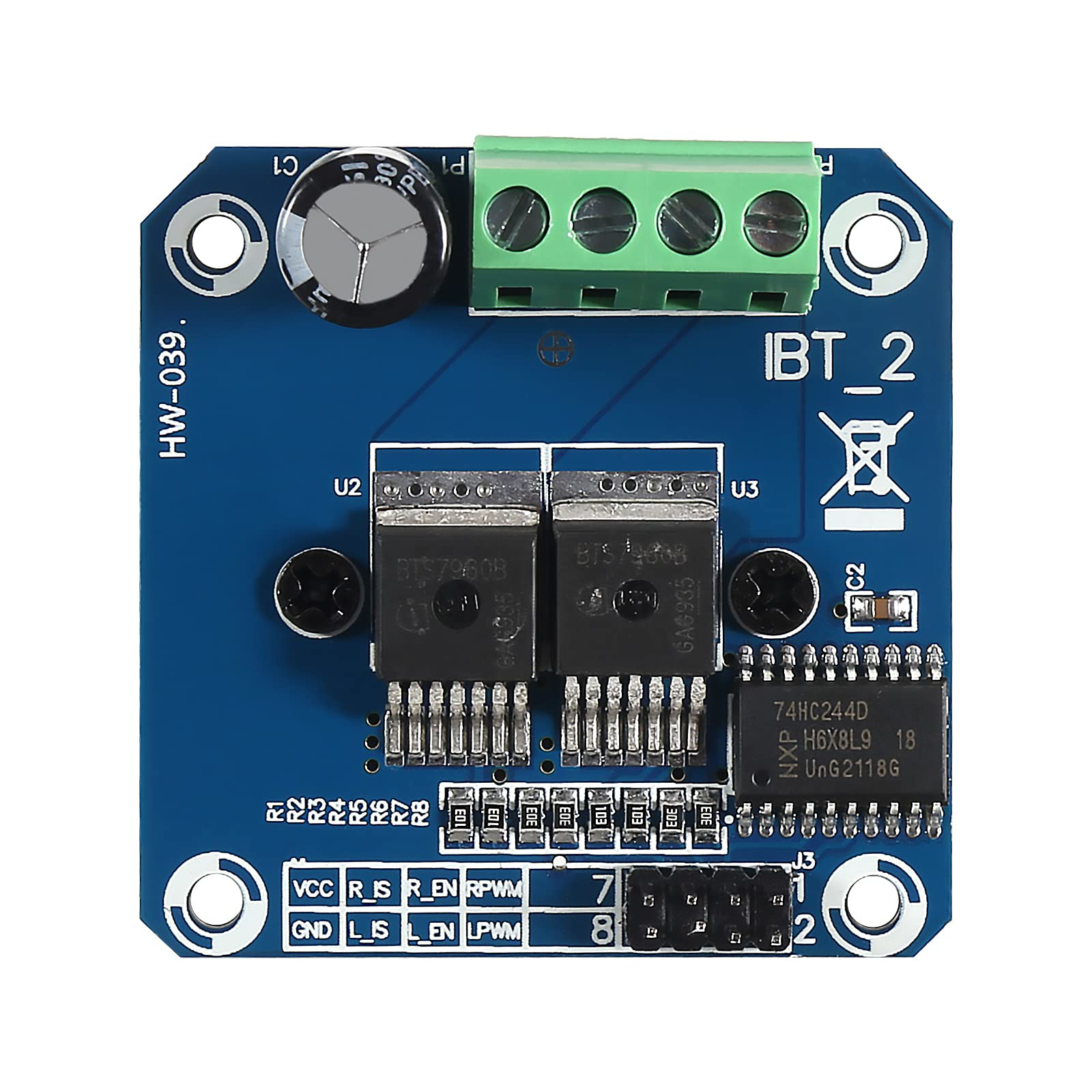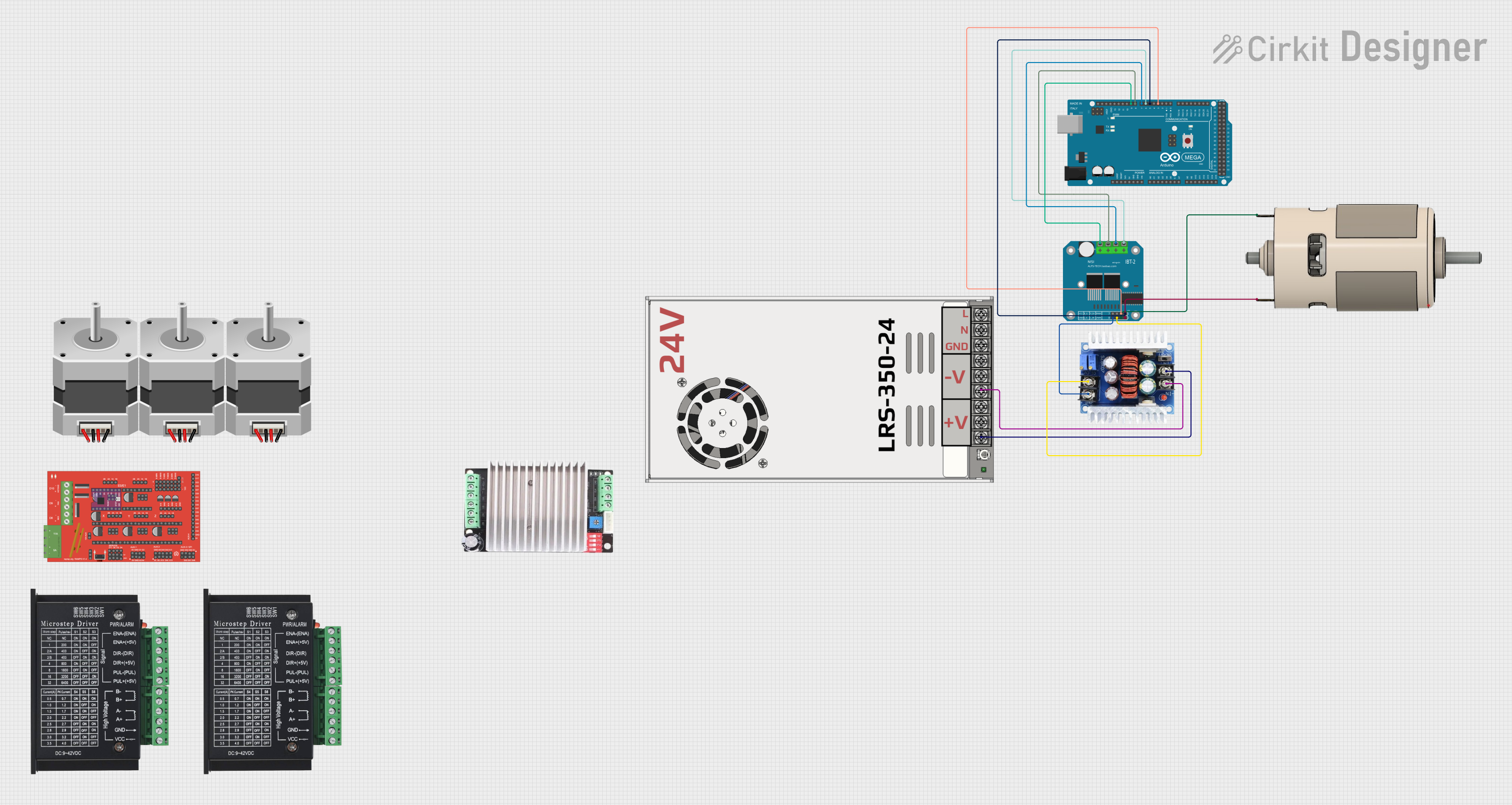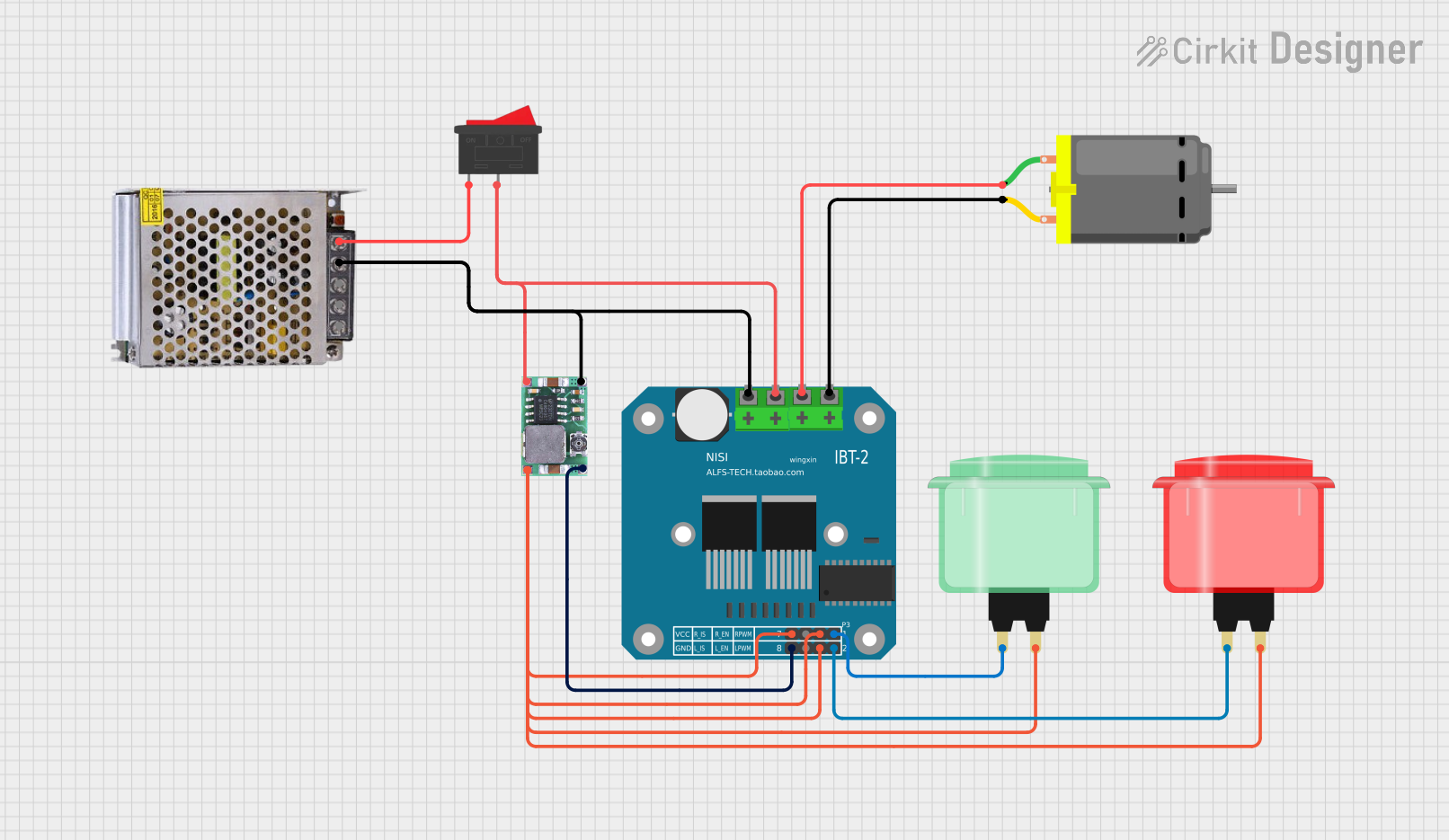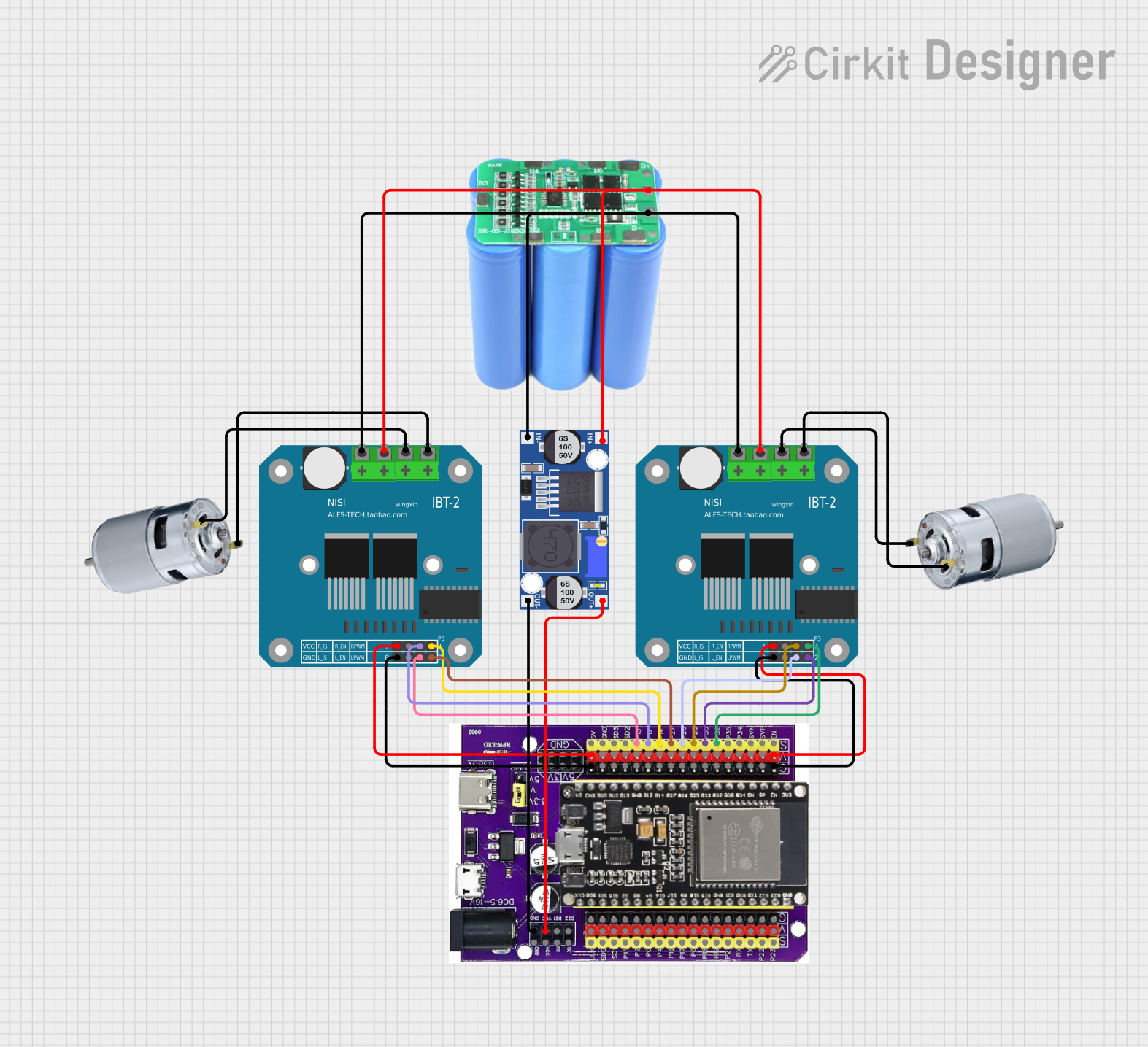
How to Use BTS7960 High Current 43A H-Bridge Motor Driver: Examples, Pinouts, and Specs

 Design with BTS7960 High Current 43A H-Bridge Motor Driver in Cirkit Designer
Design with BTS7960 High Current 43A H-Bridge Motor Driver in Cirkit DesignerIntroduction
The BTS7960 is a robust and powerful motor driver designed to control DC motors with high current ratings of up to 43A. It features an H-Bridge configuration, enabling bidirectional control of motors, making it ideal for applications such as robotics, automation, electric vehicles, and industrial machinery. With built-in protection features like overcurrent and thermal shutdown, the BTS7960 ensures reliable and safe operation in demanding environments.
Explore Projects Built with BTS7960 High Current 43A H-Bridge Motor Driver

 Open Project in Cirkit Designer
Open Project in Cirkit Designer
 Open Project in Cirkit Designer
Open Project in Cirkit Designer
 Open Project in Cirkit Designer
Open Project in Cirkit Designer
 Open Project in Cirkit Designer
Open Project in Cirkit DesignerExplore Projects Built with BTS7960 High Current 43A H-Bridge Motor Driver

 Open Project in Cirkit Designer
Open Project in Cirkit Designer
 Open Project in Cirkit Designer
Open Project in Cirkit Designer
 Open Project in Cirkit Designer
Open Project in Cirkit Designer
 Open Project in Cirkit Designer
Open Project in Cirkit DesignerCommon Applications
- Robotics (e.g., controlling wheels or robotic arms)
- Automation systems
- Electric vehicles
- Conveyor belts and industrial machinery
- High-power motor control in DIY projects
Technical Specifications
The BTS7960 motor driver is designed to handle high-power motors with ease. Below are its key technical specifications:
| Parameter | Value |
|---|---|
| Operating Voltage | 5.5V to 27V |
| Maximum Continuous Current | 43A |
| Peak Current | 50A |
| Logic Voltage | 3.3V or 5V (compatible) |
| PWM Frequency | Up to 25kHz |
| Control Inputs | 2 PWM pins, 2 direction pins |
| Overcurrent Protection | Yes |
| Thermal Shutdown | Yes |
| Dimensions | 43mm x 43mm x 28mm |
Pin Configuration and Descriptions
The BTS7960 module has several pins for motor control and power connections. Below is the pinout:
Control Pins
| Pin Name | Description |
|---|---|
| R_EN | Right motor enable (active HIGH) |
| L_EN | Left motor enable (active HIGH) |
| R_PWM | PWM signal for right motor direction |
| L_PWM | PWM signal for left motor direction |
| VCC | Logic voltage input (3.3V or 5V) |
| GND | Ground for logic and power |
Power and Motor Connections
| Pin Name | Description |
|---|---|
| V+ | Motor power supply (5.5V to 27V) |
| GND | Ground for motor power |
| MOTOR+ | Positive terminal of the motor |
| MOTOR- | Negative terminal of the motor |
Usage Instructions
The BTS7960 motor driver is straightforward to use in a circuit. Follow the steps below to integrate it into your project:
Connecting the BTS7960
- Power Supply: Connect the motor power supply to the
V+pin and ground to theGNDpin. Ensure the power supply matches the motor's voltage requirements. - Motor Connections: Connect the motor terminals to the
MOTOR+andMOTOR-pins. - Logic Connections:
- Connect the
VCCpin to the 5V or 3.3V logic supply of your microcontroller. - Connect the
GNDpin to the ground of your microcontroller. - Use the
R_ENandL_ENpins to enable the motor driver. - Use the
R_PWMandL_PWMpins to control the motor's speed and direction via PWM signals.
- Connect the
Example Arduino Code
Below is an example of how to control the BTS7960 with an Arduino UNO:
// Define control pins for the BTS7960
#define R_EN 7 // Right enable pin
#define L_EN 8 // Left enable pin
#define R_PWM 9 // Right PWM pin
#define L_PWM 10 // Left PWM pin
void setup() {
// Set control pins as outputs
pinMode(R_EN, OUTPUT);
pinMode(L_EN, OUTPUT);
pinMode(R_PWM, OUTPUT);
pinMode(L_PWM, OUTPUT);
// Enable the motor driver
digitalWrite(R_EN, HIGH); // Enable right motor
digitalWrite(L_EN, HIGH); // Enable left motor
}
void loop() {
// Example: Rotate motor forward at 50% speed
analogWrite(R_PWM, 128); // Set right PWM to 50% duty cycle
analogWrite(L_PWM, 0); // Set left PWM to 0 (no reverse)
delay(2000); // Run motor for 2 seconds
// Example: Rotate motor backward at 75% speed
analogWrite(R_PWM, 0); // Set right PWM to 0 (no forward)
analogWrite(L_PWM, 192); // Set left PWM to 75% duty cycle
delay(2000); // Run motor for 2 seconds
}
Important Considerations
- Heat Dissipation: The BTS7960 can handle high currents, but it may generate heat. Use a heatsink or active cooling for prolonged high-current operation.
- Power Supply: Ensure the motor power supply can provide sufficient current for the motor and driver.
- PWM Frequency: Use a PWM frequency below 25kHz for optimal performance.
- Protection Features: The module includes overcurrent and thermal protection. If the driver shuts down unexpectedly, check for overheating or excessive current draw.
Troubleshooting and FAQs
Common Issues and Solutions
Motor Not Running
- Ensure the
R_ENandL_ENpins are set HIGH to enable the driver. - Verify the motor power supply is connected and providing the correct voltage.
- Ensure the
Motor Running in the Wrong Direction
- Check the polarity of the motor connections (
MOTOR+andMOTOR-). - Verify the PWM signals on the
R_PWMandL_PWMpins.
- Check the polarity of the motor connections (
Driver Overheating
- Ensure proper heat dissipation with a heatsink or fan.
- Check that the motor is not drawing more current than the driver's maximum rating.
No Response from the Driver
- Confirm the
VCCpin is connected to the correct logic voltage (3.3V or 5V). - Verify all ground connections are properly connected.
- Confirm the
FAQs
Q: Can I use the BTS7960 with a 3.3V microcontroller like the ESP32?
A: Yes, the BTS7960 is compatible with both 3.3V and 5V logic levels.
Q: What is the maximum motor voltage the BTS7960 can handle?
A: The BTS7960 can handle motor voltages between 5.5V and 27V.
Q: Can I control two motors with one BTS7960 module?
A: No, the BTS7960 is designed to control a single motor. For dual-motor control, use two modules.
Q: How do I know if the driver is overheating?
A: The BTS7960 has a built-in thermal shutdown feature. If it overheats, it will automatically disable itself until it cools down.
By following this documentation, you can effectively use the BTS7960 motor driver in your projects.